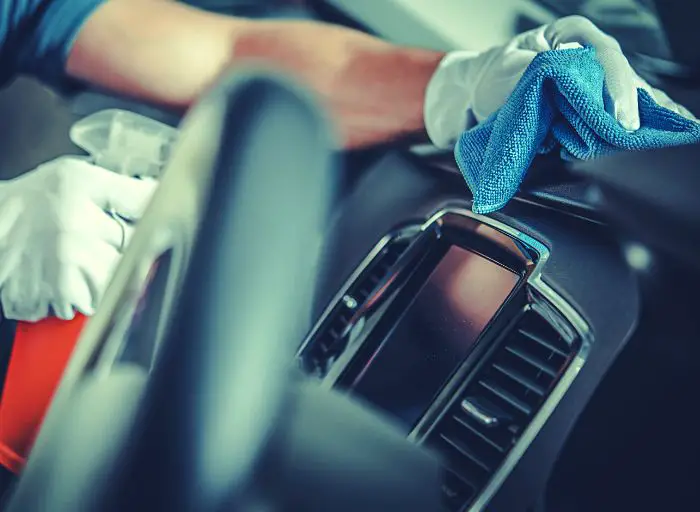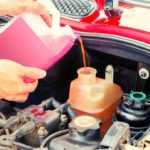The focus of car interior detailing is internal aesthetics. However, interior detailing is more complex than first appears. It is not sufficient to only appear good. For a pleasant driving experience, the inside of a car should have a clean, fresh, and hygienic atmosphere. This entails deep cleaning methods that disinfect surfaces, including floors, carpets, and upholstery, for a germ-free result.

High-quality interior detailing takes planning, diligence, and a set procedure. So even if you’re a detailing provider or user, an insight into car interior detailing is a must.
What Is Interior Detailing for Cars?
Car interior detailing is all about cleaning and protecting the interior of a car.
Detailing the interior of an automobile involves a process. Vacuuming and steam cleaning are two of the cleaning techniques used.
The first step is vacuuming the carpets, floor mats, seats, and trunk to get rid of all the crumbs, dust, and other debris.

Depending on the material of the seat, upholstery is shampooed or rejuvenated using specialist techniques.
If installed, child safety seats must also be carefully cleaned.
It is necessary to clean and polish the windows, vents, door handles, dashboard, steering wheel, gear stick, and all other surfaces, including the dials and switches.
After that, you can add your unique finishing techniques to make an automobile look brand new. Learn everything there is to know about automobile interior detailing by reading on.
Why Is Interior Detailing Necessary?
A professional car detailing aims to protect a car’s interior and maintain it in new condition for an extended period of time. It is insufficient to only wipe down the interior surfaces. Whether your car is new or used, a professional detailing service can make it look like it just left the manufacturer or the dealer.
The benefits of auto detailing are numerous. The following are some justifications for getting your car thoroughly cleaned and detailed:
#1 Removes odor
By eliminating dirt and grime and applying an odor remover to offensive scents, interior detailing gets rid of odors. Contrary to odor eliminators, air fresheners only mask offensive odors temporarily.
#2 Protect the upholstery
Sun damage may occur if your car’s windows are not tinted. The textiles and finishes inside your car might sustain long-term harm from UV radiation. The upholstery in your automobile will last longer if the interior is kept clean.
Moreover, dust and dirt will build up on the upholstery. If left uncleaned, the color of the upholstery will fade and become dirty.
#3 Stain removal and prevention
Vinyl, leather, plastics, carpeting, and fabrics are just a few of the materials used to create a vehicle’s surfaces. Regular car detailing can help you avoid and get rid of unattractive stains.
#4 Enhanced road safety
If debris is all over your car’s windows, side mirrors, and windshield, you won’t be able to see where you’re going when driving. Cleaning these surfaces is essential for better visibility and general safety.
#5 Avoid health problems
You are constrained to a small space when you sit behind the wheel of your car. The air quality inside your automobile will be poor even with an air filter if it is full of dust, dirt, and other contaminants. Fortunately, you may prevent allergies and other health issues linked to poor air quality by polishing your automobile.
#6 Increase resale value
Regular detailing helps ensure that your car retains its worth if you ever decide to sell it. To keep your car in a state that will appeal to potential purchasers, detail it often.
Interior Detailing Procedure Step-by-Step
How is the interior of a car detailed?
Each detailer has a unique method for thoroughly cleaning the interior. The standard interior detailing process that an automobile should go through is listed below. Keep in mind that this process works well for DIY interior detailing at home.
#1 Remove all loose objects
Remove all loose objects first, then place them in bags marked “loose items” for the owner. It is important to keep an eye out for odd objects, such as weapons, knives, or anything else not often found in automobiles.
#2 Remove seat covers, ashtray & mats
Take off all seat covers, including ashtrays and carpets. Ashtrays need to be thoroughly cleaned; therefore, soak them. Mats should be vacuumed and prepared to get rid of oil and embedded filth.
#3 General cleaning using an air compressor
Purge any loose debris from the vehicle using your air compressor by cleaning the interior of the back window, the rear floors, and the front of the vehicle.
Use the air compressor sparingly around the vents and the top of the dashboard. Air vents should be handled with care to prevent breaking or to move them.
Use caution when looking for needles, razor blades, or other potentially harmful items under the seats.
#4 Get rid of any pet hair
Get rid of any pet hair. If it isn’t falling out, mix two ounces of fabric softener with a quart of water and spritz the region. Of course, after completing the above steps, you can always vacuum.
#5 Clean the headliner
It’s time to clean the headliner with soap. If the headliner is sagging or looks to be loose, do not clean it or soak it in water. Instead, use a freshly cleaned sponge to remove any extra soap before drying with a towel.
#6 Clean door panels

Sanitize the door panels. Prepare a bucket of warm water and a clean microfiber towel, then soak the towel in the cleaner of your choice and thoroughly clean the panel, taking care to get rid of any dirt, especially around the handles and buttons. You can use a brush if required. Use a fresh, dry towel to dry them.
#7 Clean dashboard area

The dashboard area should be thoroughly cleaned. Use the appropriate detail brush to clean the knobs, crevices, and vents, and then dry the area with a fresh interior microfiber towel. Remove water with caution from buttons, vents, and crevices.
#8 Clean the center, levers, and other interior parts

Clean all pedals, levers, pockets, the center console, the space in between the seats, seat handles, and any other fixed interior components. Keep an eye out for spills or stains that require extra cleaning.
#9 Clean car seats

Clean the seat upholstery, seat belts, and glove box. During the dressing stage, if the interior has leather seating surfaces, clean them with a leather cleaner and condition them with a leather conditioner.
#10 Clean carpets & mats
Dirty carpets and matting should be pre-scrubbed. Use carpet shampoo and a degreaser or tar remover for very dirty regions.
Then, clean the carpets and upholstery using a heated interior extractor and the appropriate soap. Spray cleaner on the unclean regions, give them a little brush and then extract. If required, repeat the extraction process.
Remember to hang them to dry. Don’t place them on the floor.
#11 Wax door jams
It’s time to wax the door jams.
#12 Apply fabric protection
Applying fabric stain prevention to seats after cleaning and drying them will help prevent soiling and stains.
#13 Apply dressings to vinyl trim & weather stripping
Apply a dressing to the vinyl trim and the weather stripping after the fabric protection. Never dress the driving wheel or pedals. Now is a good time to condition leather if you haven’t done it.
#14 Clean gauges & chrome trim

Glass cleaner should be used to clean the gauges and chrome trim. Check for smudges and missed spots.
#15 Clean interior windows
Clean the interior windows. Use two or more microfiber towels without oils or polishes that you save for washing windows. Polish the glass and dry it with the additional clean towel.
#16 Eliminate car odor
If necessary, install an ozone machine in the car to improve the air quality and get rid of any scents that might still be present after the interior has been cleaned.
#17 Put back everything
Put the floor mats back in place. Place the car mats in the trunk, keeping them apart if the carpets are wet. Replace all objects taken from the car, including any loose items put in at the start of the detailing process.
#18 Final check
Make sure the seat backrests, headrests, AC vents, seats, and inside mirrors are properly positioned.
Basic Interior Detailing Tools & Equipment
What tools, chemicals, and supplies are required to perform a proper interior detailing job?
Car Interior Detailing Tools
- Vacuum Cleaner
- Extractors for carpet and upholstery
- Steamer
- Ozone Generator (Preferable)
Vacuum Cleaner

Your vacuum cleaner is a must-have for your professional auto detailing kit. One machine may be used to blow, vacuum, inflate, and dry, utilizing various attachments and settings.
Extractors for carpet and upholstery

A quality extractor can make carpets and upholstery appear like new. This is one of the most pricey tools in an auto detailing package. It can cost anywhere between $500 and $2,000 in total. The most expensive choices are effective, small, and only need one power source (especially important if you do mobile detailing.)
Steamer

A steamer is an incredibly helpful detailing tool for a variety of purposes. It will sanitize and clean the cup holders, dashboards, and headliners. Additionally, it can be used to spot-treat the upholstery or even get chewing gum out.
Ozone Generator
Although it is not necessary, an ozone generator might be a helpful piece of car cleaning equipment. In a few hours, it may completely eliminate scents like smoke or mold when connected to the dashboard.
Chemicals for car interior detailing
- Auto Glass Cleaners
- Carpets and upholstery Cleaners
- Leather Cleaners
- Odor Eliminators
Auto Glass Cleaners: Compared to household glass cleaners, auto glass cleaners are more effective and can even remove tar, exhaust film, and bugs.
Cleaners for carpets and upholstery can be used all over the inside of the automobile or just to certain areas. Some can even get rid of coffee stains.
Leather Cleaners: To clean, condition, and protect leather interiors without causing damage, use specialized automotive leather cleaners.
Odor Eliminators: After detailing a car, using odor eliminators leaves it smelling clean and fresh.
How Much Do Interior Detailing Services Cost?
You might be curious about why automobile detailing costs vary so much if you decide to hire a team of experts and are looking for the best offer. The straightforward response is that every auto detail company is unique. The varying detailing fees per job depends on a number of factors, including location, the size of the detail shop, the packages available, and the time devoted to some specialty services.
Time & effort
Prices for interior automobile detailing often reflect the time and effort required to complete the task. You can opt to pay a regular charge for a simple interior cleaning. Interior vacuuming and surface polishing will be part of this. Alternatively, you can pay more for premium services that include everything from stain removal to sanitation. The cost of additional services like upholstery or dashboard repairs will increase.
You should break down the costs
Examine the breakdown of costs carefully when comparing the prices charged by various services for car detailing. Learn what you are really purchasing. Detailers with a good reputation and a solid track record will be delighted to share the specifics of their various packages. You can use this to assess the value that comes with a service at a particular cost.
How Often Should Your Car Be Detailed?
Experts in car detailing advise thorough detailing your car at least twice a year. Depending on the condition of your car and your needs, you can also get it done. Regular car washing, waxing, and other services carried out twice a year can keep it clean and protect it from toxins.
Remember that no amount of cleaning or detailing can restore your car to its showroom sheen if you don’t properly maintain and care for it. We advise you to plan regular car washes and detailing appointments.
Where Can I Find Interior Detailing Near Me?
You have many options when deciding where to go for a car interior detailing.
# DIY Interior Detailing
You can clean your automobile’s interior at home if you have the time and resources. Homemade solutions can frequently get rid of minor stains and odors.
# Choose a Moblie Detailer
You can also hire a mobile detailer. Wherever is most convenient for you, this easy service can be performed on your driveway or at your place of employment.
# Interior Detailing Service at a Car Wash
A self-service car wash that also offers interior cleaning is another option.
# Opt for A Professional Detailer
You can also go to a professional detailer as an alternative.
5 Crucial Dos and Don’ts for Detailing the Interior of a Car
Professional auto detailers frequently follow a meticulous process and pay close attention to every last detail. To guarantee that your results are flawless, follow their advice. There are five key dos and don’ts for thorough interior detailing:
1. Prepare the car first
Good inside car detailing cannot be rushed. One of the common errors individuals make is not properly preparing the car in advance. Without a thorough clean-up first, it is impossible to perform the task to the highest standard.
2. Seat belts must be checked
Seat belts and buckles are commonly handled things in cars, but because they retract when not in use and then rest flush against the seat, they are sometimes missed while detailing the inside of cars.
Belts hold dirt and stains, therefore, it’s critical to include them in car interior detailing. The fabric may become stained by food spills, coffee splatters, hand cream transfers, and other things.
3. Is the underneath of the child safety seats cleaned?
Crumbs are typically present wherever there are young children. It is the same in the car, particularly if children are eating while driving. Therefore, it is necessary to regularly vacuum and clean child car seats.
However, it’s common for people to overlook cleaning behind the seats. The safety seat should always be entirely removed to allow for cleaning and access to the upholstery below.
Another area people overlook when detailing their automobile is the creases between the seats. To get the greatest clean possible in tight spots, use the vacuum cleaner’s nozzle attachment.
4. Pay attention to the AC vents

More than a simple wipe-down is required for AC vents. When detailing the interior of a car, it is not sufficient to simply clean the surface. You must also squeeze yourself between the slats.
Over time, neglecting the AC vents could produce an unpleasant musty stench.
5. Use the proper cleaning supplies for spotless windows
The inside of windows will change after using a glass cleaner. To avoid streaky windows, make sure to spray straight onto the cloth first.
Using the correct kind of cloth is crucial to ensure a gleaming, streak-free finish.
Lint and fluff can be left behind on the glass by paper towels. After cleaning, use a microfiber cloth to rub the glass.
Additionally, this kind of cloth works well for cleaning door panels and other simple interior detailing tasks like wiping down vinyl.
Thank you for reading, for more useful articles, please visit cardetailingart.com!!!







